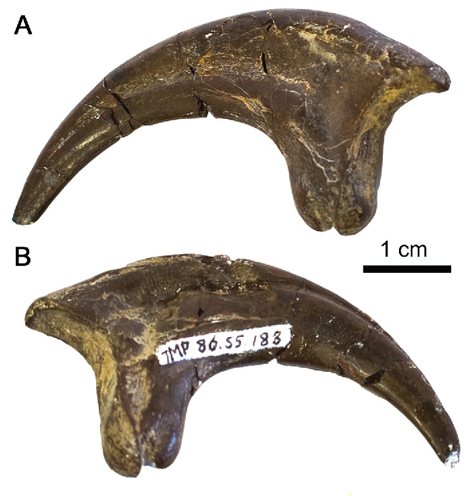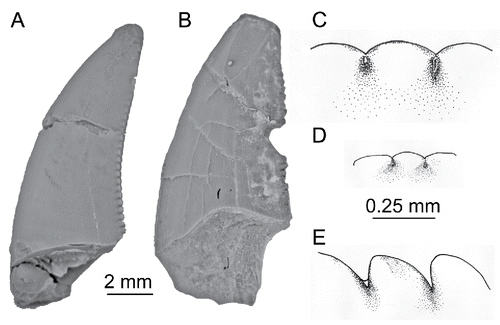A Polar Dromaeosaurid – Boreonykus certekorum
Picking over the carcases of the remnants of a herd of pachyrhinosaurs some seventy-two and a half million years ago was a small, theropod dinosaur named Boreonykus (B. certekorum), the scene, taking place in the high latitudes of northern Canada has been pieced together after painstaking research by two famous palaeontologists who have collaborated on a number of projects helping to increase our understanding of the lives and behaviours of dinosaurs that lived in high latitudes, the so called “polar dinosaurs”.
Polar Dromaeosaur
Publishing in the open access on line journal “The Journal of Vertebrate Paleontology”, please excuse the American spelling of palaeontology, scientists Philip Currie and Phil Bell report on the new dromaeosaurid material described from an extensive horned dinosaur bonebed located at Pipestone Creek, near the city of Grande Prairie (Alberta, Canada). This dog-sized little theropod has been tentatively assigned to the Velociraptorinae “wing” of the Dromaeosauridae (no pun intended), thus making Boreonykus potentially a close relative of the famous Velociraptor from Asia.
A Pair of Boreonykus Dinosaurs Feast on the Carcase of a Pachyrhinosaurus (P. lakustai)

A pair Boreonykus feeding on the corpse of a Pachyrhinosaurs lakustai.
Picture credit: Canadian Press
Polar Dinosaurs
Australian Phil Bell (School of Environment and Rural Science at the University of New England), has worked on a number of polar dinosaurs, including several known from Australia, which, for much of the Cretaceous would have been part of high latitude environments in the Southern Hemisphere, so it could be said that Dr Bell has researched dinosaurs at the opposite ends of the Earth. Isolated teeth had been found in association with the fossilised bones of the horned dinosaur Pachyrhinosaurus lakustai back in 1988, but they were thought to have been shed by other feeding, small-bodied theropods that had already been scientifically described.
Previous studies had concluded that these small theropod fossils found in the extensive Pipestone Creek bonebed belonged to Saurornitholestes langstoni or possibly Dromaeosaurus albertensis. However, when more fossil material was found in 2012 including a portion of the skull (the frontal), scientists began to realise that the teeth and isolated bone fragments caught up in the huge plaster jackets of the giant Pachyrhinosaurus excavations, might just be something entirely new.
Comparison of Three Frontal Bones of Members of the Dromaeosauridae

The angle of the frontal bone in relation to the supratemporal ridges led to a new dinosaur.
Picture credit: The Journal of Vertebrate Paleontology with additional annotation by Everything Dinosaur
Skull Bone Provides Vital Clue
It was when the frontal bone from the Pipestone Creek bonebed was compared to the frontal bones of Saurornitholestes and Dromaeosaurus that the researchers noticed a vital difference. The angle between the frontal and the supratemporal ridges on the skull was much more acute. This suggested that the theropod material found did represent a new genus of small, agile hunter.
The picture above shows a comparison of dromaeosaurid frontal bones (dorsal view). The angles between the supratemporal ridges are given. The fifty-five degree angle for the frontal assigned to B. certekorum is noticeably smaller.
Phil Bell and the Polar Dromaeosaur
Commenting on the study, Phil Bell explained that the frontal was the most important bone, that helped to clinch what type of animal it was and led to the erection of a new genus.
Dr Bell added:
“Its [Boreonykus] closest ancestors were from Mongolia, so this species probably crossed the land bridge from northern Asia to North America. The first bones were discovered in 1988 and laid unstudied in a museum in Alberta for 25 years. We then started to turn up a few more bones from the very same spot in 2012, so that reinvigorated interest. Although we don’t have the whole skeleton, we know, based on parts of the skeleton, that it belonged to this type of dinosaur. The raptors’ skin was probably feathered to keep them warm in the cold dark winters in north Canada.”
The Sickle-Claw from the Second Toe of the Left Hind Foot

The killing toe claw of the “raptor” Boreonykus. Scale bar = 1 centimetre.
Picture credit: The Journal of Vertebrate Paleontology
Boreonykus certekorum
The genus name Boreonykus is a reference to the modern day boreal forest where the type specimen was found and “onychos” is from the Greek meaning claw. The species name honours Certek Heating Solutions and the Barendregt family of Wembley, Alberta, who have sponsored the field work and supported efforts to record and preserve the fossil fauna of this part of Alberta.
More than 99% of all the fossil material recovered from the Pipestone Creek bonebed has been assigned to the centrosaurine Pachyrhinosaurus (P. lakustai), some fragmentary Edmontosaurus fossils may have also been found (we think) along with evidence of other theropods. The bonebed is very dense and there are up to two hundred bones per square metre, the other theropod material found to date consists of shed teeth assigned to Troodon and indeterminate tyrannosaurids.
Two Shed Tooth Crowns from the Pipestone Creek Site Assigned to B. certekorum

Two shed teeth from the Pipestone Creek bonebed assigned to Boreonykus.
Picture credit: The Journal of Vertebrate Paleontology
Examining Fossil Teeth
The picture above shows two shed teeth from the bonebed which have been assigned to the new Velociraptorinae genus. The dating of the bonebed is not precise, however, a volcanic ash layer approximately one metre above the site has been dated to 73.27 million years ago +/- 250,000 years.
The researchers comment that all the material assigned to Boreonykus probably came from a single individual and the identification of a new dromaeosaurid, classified as a eudromaeosaur (a sub-group of the Dromaeosauridae family) and possibly a member of the Velociraptorinae, a sub-family of the Dromaeosauridae, if this is the case, it extends the known palaeofauna of the polar dinosaurs in northern latitudes to include Velociraptorinae and extends the known record of North American theropods which are closely related to the predominately Asian Velociraptors and their close relatives.
For articulated models of dromaeosaurids and other dinosaurs: Beasts of the Mesozoic Articulated Models.





